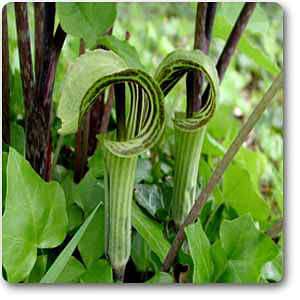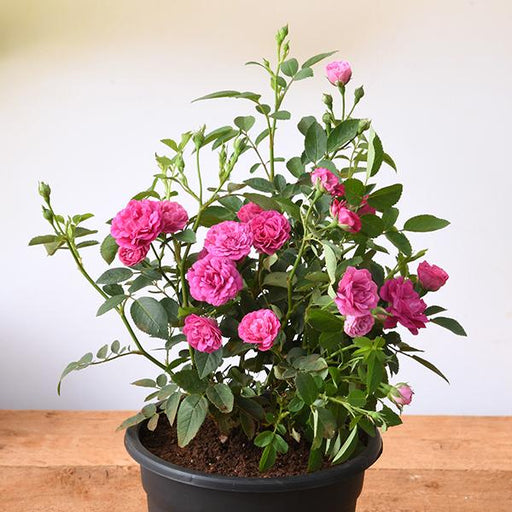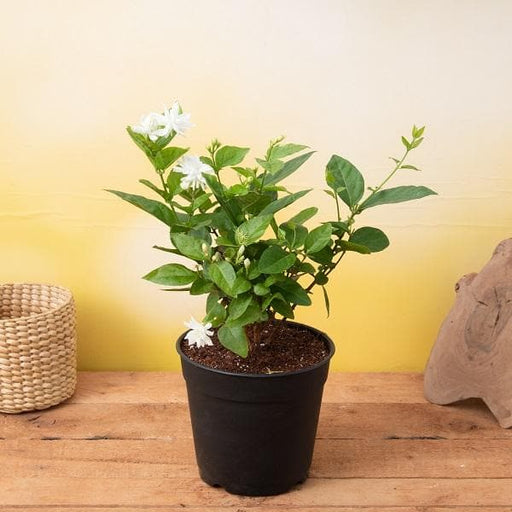
Arisaema triphyllum - Plant
(MRP Inclusive of all taxes)
- Shipping ₹79 for entire order
- Dispatch in 7 days
- Country of origin: India

(MRP Inclusive of all taxes)
 Save 29%
Save 29%
Air Purifier Money Plant with Pot The Air Purifier Money Plant, also known as Pothos or Epipremnum aureum, is a stunning indoor plant that...
View full details
 Save up to 15%
Save up to 15%
Peace Lily, Spathiphyllum - Plant The Peace Lily, scientifically known as Spathiphyllum, is a stunning houseplant celebrated for its elegant white...
View full details
 Save 25%
Save 25%
Jasminum sambac, Mogra, Arabian Jasmine - Plant Jasminum sambac, commonly known as Mogra or Arabian Jasmine, is a fragrant flowering plant...
View full details
 Save 18%
Save 18%
Combo Constituents Includes the Parijat Tree (Night-Flowering Jasmine), a culturally significant plant with fragrant flowers. Description The Pari...
View full details
 Save 25%
Save 25%
Miniature Rose, Button Rose (Any Color) - Plant The Miniature Rose, also known as the Button Rose, is a charming and compact flowering plant that ...
View full details Save 25%
Save 25%
Damascus Rose, Scented Rose (Any Color) - Plant The Damascus Rose, also known as Rosa damascena, is a timeless symbol of beauty and romanc...
View full details
 Save 17%
Save 17%
Beautiful Fragrant Mogra, Arabian Jasmine Plant with Pot The Beautiful Fragrant Mogra, also known as Arabian Jasmine (Jasminum sambac), is...
View full details Save 15%
Save 15%
Pack of Vermicompost and Neem Cake for House Plants Transform your indoor garden with our premium Pack of Vermicompost and Neem Cake, spec...
View full details
Pack of Plant Growth and Flower Boosters Unlock the full potential of your garden with our Pack of Plant Growth and Flower Boosters! This ...
View full details Save 38%
Save 38%
Combo of Jeevamrut and Neem Raksha for Easy Growth and Protection of Houseplants Transform your indoor garden with our exclusive combo of ...
View full details Save 22%
Save 22%
Plant Nutrients Kit (Pack of 16) for a Healthy Garden Transform your garden into a lush paradise with our Plant Nutrients Kit, featuring 1...
View full details Save 16%
Save 16%
Combo of Top Plant Fertilizers Elevate your gardening game with our exclusive Combo of Top Plant Fertilizers, featuring two bags of premiu...
View full details Save 24%
Save 24%
Pack of 4 Additives to Make Soil Healthy and Nutrient Rich Transform your garden into a thriving ecosystem with our Pack of 4 Additives de...
View full details Save 30%
Save 30%
Transform your gardening experience with our premium Combo of Perlite and Vermiculite. This unique blend is designed to enhance soil aeration and ...
View full details Save 27%
Save 27%
Combo of 2 Vermicompost and Cocopeat - Enrich Your Soil Naturally! Transform your garden into a thriving ecosystem with our Combo of 2 Ver...
View full details
 Save 35%
Save 35%
Best 6 Plants for Perfect Indoor Garden Transform your living space into a lush oasis with our curated collection of the Best 6 Plants for a...
View full details
 Save up to 50%
Save up to 50%
Mini Succulent Garden Pack Transform your space with our Mini Succulent Garden Pack, featuring a delightful collection of 4 any variety beautiful s...
View full details
 Save 30%
Save 30%
5 Best Fragrant Plants Transform your garden or indoor space into a fragrant paradise with our curated selection of the 5 Best Fragrant Plants. Th...
View full details
 Save 24%
Save 24%
Set of 2 Bonsai Looking Grafted Adeniums Transform your indoor or outdoor space with our exquisite Set of 2 Bonsai Looking Grafted Adenium...
View full details Save 45%
Save 45%
Top 4 Die Hard Succulents Pack Transform your indoor or outdoor space with our Top 4 Die Hard Succulents Pack, featuring a curated selecti...
View full details
 Save 30%
Save 30%
5 Best Indoor Plants Pack Transform your living space into a lush oasis with our '5 Best Indoor Plants Pack.' This carefully curated collection fe...
View full details
 Save 25%
Save 25%
Set of 4 Evergreen Air Purifier Plant Pack Transform your indoor space into a lush, green oasis with our Set of 4 Evergreen Air Purifier Pla...
View full details| SrNo | Item Name |
|---|---|
| 1 | Arisaema triphyllum - Plant |
Arisaema triphyllum, commonly known as Jack-in-the-Pulpit, is a striking perennial plant native to the woodlands of North America. This unique plant features a distinctive hooded flower that resembles a pulpit, making it a fascinating addition to any garden. With its lush, green, trifoliate leaves and intriguing inflorescence, it thrives in shaded areas, adding a touch of elegance to woodland gardens and shaded landscapes.
What makes Arisaema triphyllum special is its ability to adapt to various soil types while providing essential habitat for local wildlife. This plant is not only visually appealing but also plays a crucial role in the ecosystem, attracting pollinators such as bees and butterflies. Its unique reproductive strategy, where it can change sex based on environmental conditions, adds to its allure and ecological importance.
One of the most remarkable features of Arisaema triphyllum is its fascinating life cycle. The plant produces a spadix surrounded by a spathe, which can vary in color from green to purple. This captivating structure not only serves as a shelter for pollinators but also contributes to the plant's unique charm, making it a conversation starter in any garden.
If you think caring for Arisaema triphyllum is like babysitting a toddler, you’re not far off! This plant thrives in moist, well-drained soil and prefers a shady spot, much like a child avoiding the sun. Water it regularly, but don’t drown it—overwatering is the plant equivalent of a tantrum. Fertilize during the growing season, and watch it flourish like a kid on a sugar high. Just remember, this plant is a bit of a diva; it likes its space and doesn’t appreciate being crowded by other plants.
Picture a cozy woodland nook, where the sun peeks through the leaves and the air is filled with the scent of damp earth. That’s the ideal habitat for Arisaema triphyllum! This plant loves to hang out in rich, moist soil under the canopy of trees. It’s like the introverted friend who prefers a quiet café over a loud party. So, if you want to cultivate this beauty, think shady spots with a touch of woodland charm.
Want to multiply your Arisaema triphyllum like rabbits? Propagation is the name of the game! You can do this through seed or division. Seeds need a bit of patience, as they require cold stratification—think of it as a winter vacation for your seeds. Division is quicker; just dig up the tubers and separate them like you’re sharing a pizza. Remember, sharing is caring, but don’t overdo it; too much division can lead to a sad, lonely plant.
Arisaema triphyllum is not just a pretty face; it’s also a bit of a troublemaker! This plant contains calcium oxalate crystals, making it toxic if ingested. So, while it may look inviting, it’s best to admire it from a distance—like that one friend who always has a wild story. Keep pets and curious kids away, or you might end up with a trip to the vet instead of a garden party.
When it comes to flowers, Arisaema triphyllum doesn’t just show up; it makes an entrance! Its unique spathe and spadix resemble a quirky hat at a garden party. The flowers bloom in spring, adding a touch of drama to your garden. They’re not just pretty; they also attract pollinators, making them the social butterflies of the plant world. Just remember, these flowers are a bit shy and prefer to hide among the foliage, so keep your eyes peeled!
If you’re looking for a speedy grower, Arisaema triphyllum might not be your best bet. This plant takes its sweet time, growing at a moderate pace. Think of it as the tortoise in the race—slow and steady wins the garden! It may take a couple of years to reach its full glory, but once it does, you’ll be glad you waited. Patience is key, and while you’re waiting, you can enjoy the anticipation of its unique beauty.
Like any diva, Arisaema triphyllum can attract unwanted attention from pests. Aphids and spider mites might try to crash the party, but don’t worry; a little neem oil or insecticidal soap can send them packing. Keep an eye out for these little intruders, and don’t let them ruin your plant’s fabulous reputation. After all, a healthy plant is a happy plant, and nobody wants a drama queen in their garden!
If Arisaema triphyllum had a wish list, well-drained, rich, and moist soil would be at the top! This plant is a bit of a soil snob, preferring a mix that retains moisture without turning into a swamp. Think of it as the Goldilocks of plants—too dry, and it’ll sulk; too wet, and it’ll throw a fit. A good mix of organic matter will keep it happy and thriving, so roll up your sleeves and get that soil just right!
Arisaema triphyllum is a shade-loving plant, much like a vampire avoiding the sun. It thrives in dappled sunlight or full shade, so don’t even think about placing it in direct sunlight unless you want it to throw a hissy fit. Too much sun can scorch its delicate leaves, so find a cozy spot under the trees where it can bask in filtered light. Your plant will thank you with lush foliage and unique blooms!
Did you know Arisaema triphyllum has a few fabulous relatives? From the striking Arisaema candidissimum to the exotic Arisaema sikokianum, there’s a whole family of unique plants to explore. Each variety brings its own flair to the garden, so why not collect them all? It’s like having a botanical fashion show right in your backyard. Just remember, each variety has its own quirks, so do your homework before inviting them to your garden party!
Arisaema triphyllum isn’t just a pretty face; it has a few tricks up its sleeve! This plant is often used in shade gardens, woodland settings, and even as a conversation starter at garden parties. Its unique appearance can add a touch of drama to any landscape, making it a favorite among garden enthusiasts. Just remember, while it’s a showstopper, it’s also a bit of a wallflower, preferring to blend in with its shady surroundings.
Arisaema triphyllum, also known as Jack-in-the-pulpit, is a quirky perennial plant native to North America. With its unique hooded flower and striking leaves, it’s like nature’s own magician, pulling off a floral illusion that leaves gardeners spellbound. Perfect for shady spots, it’s the drama queen of the woodland garden!
Caring for Arisaema triphyllum is like nurturing a diva; it loves rich, moist soil and partial shade. Water it regularly, but don’t drown it—this plant prefers a gentle mist rather than a torrential downpour. Mulch is its best friend, keeping the roots cool and happy while preventing weeds from crashing the party!
Arisaema triphyllum typically blooms in late spring to early summer, showcasing its stunning flower from April to June. The bloom resembles a little green and purple umbrella, perfect for those rainy days in the garden. Just be patient; good things come to those who wait, especially when it comes to this botanical beauty!
Plant Arisaema triphyllum in a shady spot with well-drained, rich soil. Think of it as the introverted artist of your garden; it thrives in quiet corners, away from the harsh sun. Ideal companions include ferns and hostas, creating a woodland wonderland that even the sunniest of plants would envy!
Yes, Arisaema triphyllum is toxic if ingested, so keep it away from curious pets and children. It contains calcium oxalate crystals, which can cause irritation and discomfort. Think of it as the plant equivalent of a spicy dish—delicious to look at but best enjoyed with caution. Safety first, garden enthusiasts!
Propagating Arisaema triphyllum is like playing matchmaker in the plant world. You can do it through seeds or by dividing the rhizomes in early spring or fall. Just ensure the new digs are cozy and moist, and soon you’ll have a thriving family of Jack-in-the-pulpits ready to steal the show!
Arisaema triphyllum is generally pest-resistant, but watch out for slugs and snails—they love to munch on its leaves! If you spot these slimy intruders, consider using organic deterrents or hand-picking them off. After all, this plant deserves a pest-free life, just like any star in the garden spotlight!
Absolutely! Arisaema triphyllum can thrive in pots, making it a versatile addition to your garden. Just ensure the pot has good drainage and fill it with rich, moist soil. It’s like giving this plant a cozy apartment—perfect for those who want to enjoy its charm without committing to a full garden!
The ideal soil for Arisaema triphyllum is rich, loamy, and well-draining, with a slightly acidic to neutral pH. Think of it as the perfect recipe for a garden cake—moist but not soggy, with plenty of nutrients to keep it thriving. Add organic matter to the mix, and watch this plant flourish!
Arisaema triphyllum can live for several years, often thriving for a decade or more with proper care. It’s like the wise old sage of the garden, offering beauty and intrigue season after season. Just give it the right conditions, and it’ll stick around to share its quirky charm for years to come!
Yes, Arisaema triphyllum is generally deer resistant, as its toxic properties make it unappetizing to these four-legged grazers. However, hungry deer can be unpredictable, so it’s wise to plant it alongside other deer-resistant companions. With a little luck, your garden will remain a safe haven for this enchanting plant!
Arisaema triphyllum is primarily used for ornamental purposes in shady gardens and woodland settings. Its unique appearance adds a touch of whimsy and intrigue. Additionally, some cultures have used it in traditional medicine, but caution is advised due to its toxicity. So, enjoy its beauty, but leave the herbal remedies to the experts!